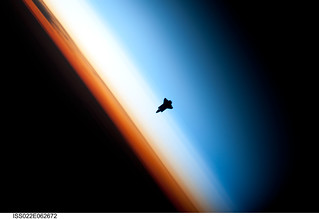Glowing sea turtle first biofluorescent reptile ever found
Meteorologist/Science Writer
Friday, October 2, 2015, 5:45 PM - A glowing sea turtle surprises divers, a "blue blood" moon and taking a flight over the chasms of Charon. It's Science Pics of the Week!
Underwater UFO turns out to be glowing turtle
There are plenty of species around the world that exhibit biofluorescence, or the ability of an animal to convert light into a glow emitted by portions of their body. However, scientists had not found any species of reptile that exhibited this ability, until now.
WATCH BELOW: While shooting video in the waters off the Solomon Islands, a surprise swam in front of the camera of David Gruber, a National Geographic Emerging Explorer.
"Blue blood" moon
During the September 27/28 lunar eclipse - which many called the "supermoon eclipse" or "super blood moon" - an interesting phenomenon made an appearance just as the moon was almost fully within the umbra, the deepest, darkest part of Earth's shadow.

Courtesy: Regis Martin, Rogersville, N.B.
The top left portion of the moon is very dark in this image, simply because the Moon is at perigee - its closest distance to Earth all year - and thus it is passing through the deepest portion of Earth's cone-shaped umbral shadow. Since the image is taken just as the Moon is fully immersed in the umbra, the edge of the umbra is showing at the bottom right edge, and it's showing up blue!
Why is this?
|
|
Although lunar eclipses turn the Moon red, Earth's umbra isn't uniformly coloured. Since all the colour in the umbra comes directly from sunlight passing through Earth's atmosphere, which is focused into the shadow by the curvature of the Earth, the umbra takes on the same layered colour pattern as the atmosphere has.
This makes the centre of the umbra an orange-red colour, from the lowest level of the atmosphere - the troposphere, where all of our weather occurs. Meanwhile, there's a band of lighter orange-yellow-white colour from the stratosphere, and finally outside that, a band of blue from the absorption of light by ozone in the mid-to-upper stratosphere and from the mesosphere.
While it's difficult to see this banding of colour when watching the eclipse with the unaided eye, getting a close-up look through binoculars, a telephoto lens or a telescope can really make the colour stand out.
Fly over Pluto's moon, Charon
We've seen some incredible new views of Pluto over the past few weeks, ever since NASA's New Horizons team began downlinking all the imagery the spacecraft took during its Pluto flyby back in July.
Now, we're being treated to the same from Charon, Pluto's largest moon (or Pluto's companion dwarf planet, if you prefer).
First up, this huge, hi-res image of Charon is
Not satisfied with simply presenting us with a static image, the New Horizons team created a computerized animation, taking us on a simulated flyover of this immense chasm.
According to NASA:
High-resolution images of the Pluto-facing hemisphere of Charon, taken by New Horizons as the spacecraft sped through the Pluto system on July 14 and transmitted to Earth on Sept. 21, reveal details of a belt of fractures and canyons just north of the moon’s equator. This great canyon system stretches more than 1,000 miles (1,600 kilometers) across the entire face of Charon and likely around onto Charon’s far side. Four times as long as the Grand Canyon, and twice as deep in places, these faults and canyons indicate a titanic geological upheaval in Charon’s past.
"It looks like the entire crust of Charon has been split open," said John Spencer, deputy lead for GGI at the Southwest Research Institute in Boulder, Colorado. "With respect to its size relative to Charon, this feature is much like the vast Valles Marineris canyon system on Mars."
What's truly amazing is, even with how good the above imagery is, it still does not reflect the best of what New Horizons gathered with its cameras as it passed by Pluto and Charon. The absolute best imagery is still in the queue, waiting to be downloaded.
"I predict Charon’s story will become even more amazing!" said Hal Weaver, New Horizons mission Project Scientist, from the Johns Hopkins University Applied Physics Laboratory.
Sources: National Geographic | Weather Network/Slooh | NASA





